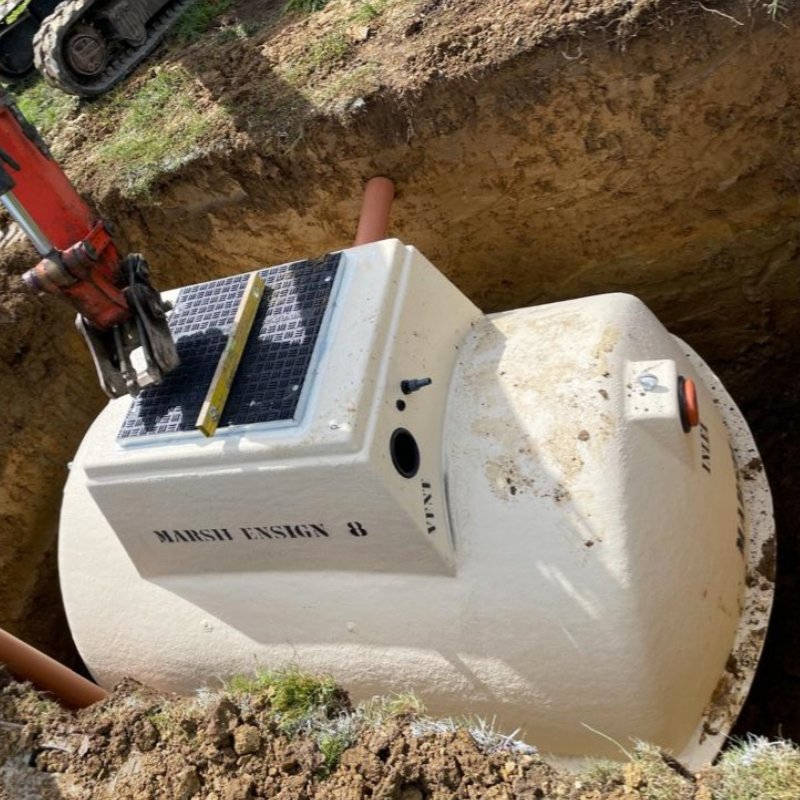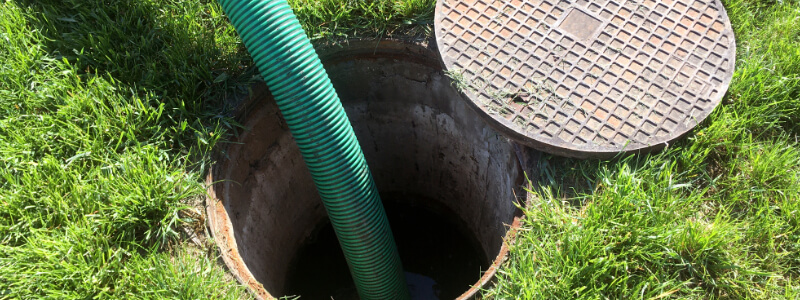In this article
How does a septic tank work?
A septic tank is a crucial component of a property's wastewater management system - particularly in areas not connected to municipal sewage systems. It serves as an underground chamber for treating and disposing of household sewage and allows for a smooth-running drainage system. If you're a homeowner, it's important for you to know how a septic tank works to ensure proper maintenance and avoid potential issues.
By gaining insight into its functioning, you can make informed decisions about its care, contributing to the longevity and efficiency of their wastewater management system. In this blog, we will take a look at what a septic tank, how it works - and why they're a good choice for your homes drainage system.
What is a septic tank?
A septic tank is an essential for a home's domestic wastewater management. It functions as an underground compartment that receives and partially treats sewage from households, allowing for the natural decomposition of organic matter and settling solid waste. A septic tank is vital for treating and purifying wastewater, ultimately facilitating its safe disposal into the surrounding environment.

What does a septic tank do?
A septic tank is a crucial component of household wastewater management. It is a buried, watertight container designed to receive and treat raw domestic sanitary wastewater. Typically made of concrete, fibreglass, or polyethene, the tank holds the wastewater, allowing natural decomposition processes to occur.
As the wastewater enters the tank, solid matter and sediment settle at the bottom, while bacterial action helps break down organic matter, partially treating the wastewater. The clarified effluent then exits the tank and is treated as it travels through the drain field before being safely disposed of.
So, how does a septic tank work?
A septic tank receives sewage from residential or commercial sources through underground pipes. The tank is designed to separate the wastewater into layers, allowing for the settling of solids and the natural decomposition of organic matter. Let's take a look at the components and what a septic tank consists of.
Components of a Septic System
Septic Tank
A septic tank typically appears as a large underground concrete or plastic container used for storing and treating household wastewater. The tank is an integral part of the septic system, serving as the primary treatment chamber for waste.
Pipes
Pipes connect the septic tank to the house and the drain field. These pipes transport wastewater from the home to the septic tank and then distribute the treated effluent to the drain field. Proper installation and maintenance of these drainage pipes are essential to ensure the efficient functioning of the entire system.
Drain Field
The drain field, or the leach field, is a network of perforated pipes in underground trenches filled with gravel. Its purpose is to disperse the liquid wastewater from the septic tank into the soil. The soil acts as a natural filter, removing harmful bacteria, viruses, and nutrients from the effluent before it enters the groundwater.
Functioning of a Septic Tank
A septic tank serves as a crucial septic system component, functioning to separate and treat household wastewater. The tank operates through a series of processes that involve the separation of solids, effluent, and scum within its structure. Let's take a look at this.
Solids:
As sewage enters the septic tank, the larger solids sink to the bottom due to the reduced flow rate. This layer consists of the heavy organic and inorganic materials present in the wastewater, such as food particles, soil, and other debris.
Effluent:
The middle layer is primarily composed of the liquid portion of the wastewater, known as effluent. It fills most of the tank and contains the dissolved and suspended organic matter that has undergone partial decomposition.
Scum:
The top layer, known as scum, comprises lighter substances like grease, oils, and other floating materials. These substances form a coating on the surface of the effluent, preventing them from escaping the tank.

Process of Waste Separation and Settling
A septic tank's functioning involves the natural waste separation and settling process. Heavy solids settle at the bottom of the tank, where they undergo anaerobic decomposition by bacteria, reducing their volume and transforming them into a more transparent liquid. Meanwhile, the scum layer prevents the escape of lighter materials, allowing the effluent to undergo further treatment before it exits the tank for dispersion into the drain field.
Bacterial Action
Bacteria play a crucial role in breaking down solid waste within septic tanks, contributing significantly to wastewater treatment. The breakdown process, facilitated by bacteria, is essential for the efficient functioning of septic systems.
In the septic tank's anaerobic environment, various types of bacteria work to decompose solid organic waste, including food particles and human waste. These microorganisms, primarily anaerobic bacteria, initiate the breakdown of organic matter, reducing its volume and transforming it into simpler compounds. This breakdown reduces the accumulation of solid waste within the tank and facilitates the conversion of organic matter into a clearer liquid effluent.
Bacteria decompose organic matter, a fundamental aspect of the wastewater treatment process. As bacteria break down solid waste, they help in the natural treatment and purification of the wastewater within the septic tank. This process ultimately contributes to safely disposing of treated effluent into the drain field, where further natural filtration occurs as the effluent percolates through the soil.
Septic Tank Regulations
As with any sewage treatment plant system, regulations and maintenance rules must be considered. In the UK, septic tank regulations are governed by the General Binding Rules, which impose specific conditions for using and maintaining a reliable septic tank and sewage treatment system.
As of 2015, the new septic tank regulations mandate that septic tanks have a drainage field to ensure proper wastewater treatment. Additionally, septic tanks can no longer discharge untreated sewage into watercourses, and if the discharge causes pollution, homeowners must take corrective measures.
Tips for Maintaining Healthy Septic Tanks and Systems
Maintaining a healthy septic system is crucial for its longevity and efficient operation. Several vital practices contribute to the proper care and maintenance of a septic system:
Regular Pumping:
Schedule regular septic tank emptying to remove accumulated solids and prevent them from clogging the system. The pumping frequency depends on household size, water usage, and tank capacity.
Water Conservation:
Practice water conservation to reduce the volume of water entering the septic system. Repair any leaks in faucets or toilets, and consider installing low-flow fixtures to minimise water usage.
Proper Waste Disposal:
Avoid flushing inappropriate substances down the drain, such as grease, oil, non-biodegradable items, chemicals, and excessive household cleaners. These substances can disrupt the natural processes within the septic tank.
Maintain Drain Field:
Protect the drain field by avoiding activities that could compact the soil, such as parking vehicles or heavy machinery over the area. Planting trees and shrubs near the drain field should also be avoided to prevent root intrusion.
Periodic Inspections:
Arrange for periodic inspections by professional septic system service providers. These inspections can reveal issues early on, allowing for timely repairs and maintenance to prevent major problems.
Importance of Periodic Inspections by Professionals
Professional inspections play a critical role in ensuring the optimal functioning of a septic system. Here's why they are essential:
- Early Problem Detection: Professional inspections can identify potential issues before they escalate into costly and disruptive problems. Early detection allows for proactive maintenance and repairs.
- System Optimisation: Inspections help optimise the septic system's performance by identifying areas that may require adjustment or improvement. This can contribute to the system's overall efficiency.
- Compliance with Regulations: Regular inspections are a legal requirement for homeowners with septic systems in many areas. Compliance with these regulations is essential to avoid penalties and ensure environmental safety.
- Expert Advice: Professional inspectors can provide valuable advice on best practices for maintaining the septic system, including tailored recommendations based on the system's specific characteristics.
Final Thoughts
A septic tank functions as a crucial component of household wastewater management by harnessing bacteria's natural decomposition abilities to break down solid waste. This breakdown process is essential for treating and purifying wastewater, ultimately facilitating the safe disposal of treated effluent into the drain field.
Proper maintenance and care
It is important that you prioritise the proper maintenance and care of your septic systems. Regular pumping, water conservation, and responsible waste disposal are essential practices that contribute to the optimal functioning of the system. Additionally, periodic inspections by professionals play a vital role in early problem detection, system optimisation, compliance with regulations, and expert advice - allowing you to look after your home efficiently.
By understanding how a septic tank works and embracing best practices for maintenance and care, you can ensure their septic systems' longevity, efficiency, and environmental safety. This proactive approach safeguards the household infrastructure and fosters a deeper understanding of this essential aspect of wastewater management.
Cotswold Drainage
At Cotswold Drainage, we help with your septic tanks and drainage needs. Please get in touch with us if you'd like to know more about how your sewage system works and how we can help with your septic tank system - from shallow dig septic tanks to larger tanks.
Get in touch
Contact our friendly and professional team via form, phone or email for any drainage issues you may have.
From blocked drains to septic tank repairs and replacements, we're here to help. We have over 25 years of experience and offer 24/7 emergency callouts.
-
01386 882324
-
WhatsApp
-
This email address is being protected from spambots. You need JavaScript enabled to view it. -
See what our customers think



